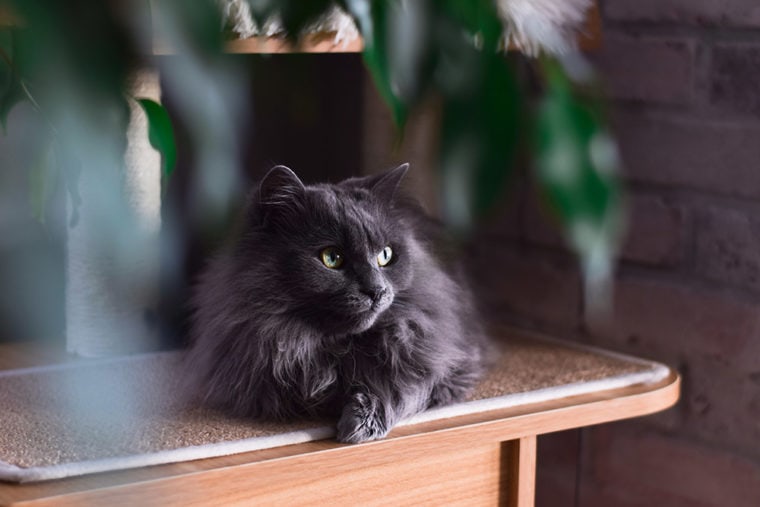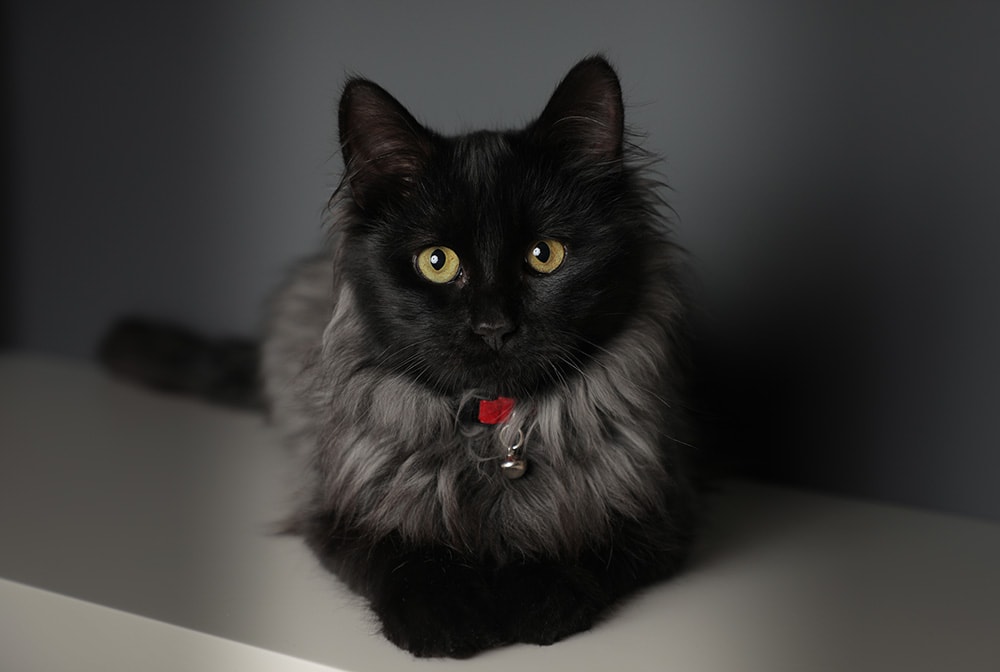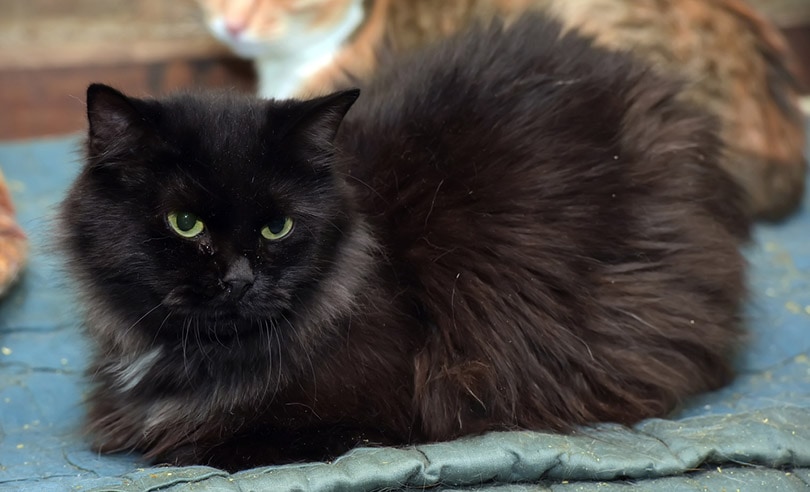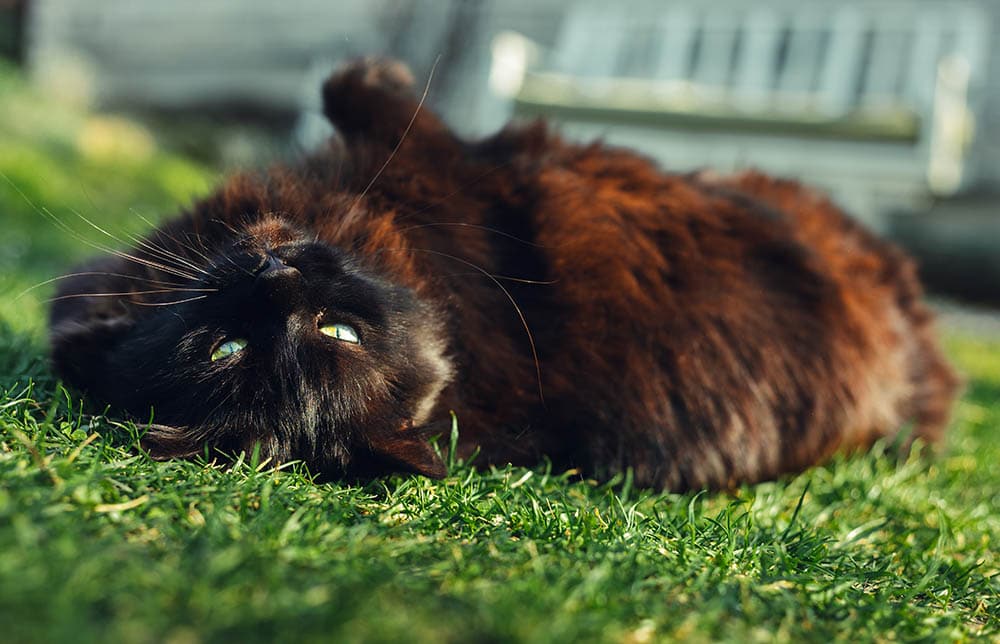
Click Below to Skip Ahead
If you’ve never heard of a Chantilly Tiffany, you’re in good company—Chantilly Tiffanys are unfortunately considered extinct as of 2015. At this time, a breeder from Norway gave up on her breeding program after the death of her Chantilly Tiffany, Frosty. Prior to this event, a fire destroyed the last Chantilly Tiffany cattery in the US and the records that were in it.
Breed Overview
Height:
8–10 inches
Weight:
6–12 pounds
Lifespan:
11–15 years
Colors:
Chocolate, fawn, blue, cinnamon, lilac
Suitable for:
Single people, seniors, families with kids—any loving and attentive family
Temperament:
Chatty, loving, affectionate, sweet-natured, people-loving
However, the name “Chantilly Tiffany” is still in use. Many long-haired black cats with golden or yellow eyes are often referred to as Chantilly Tiffanys, though original Chantilly Tiffanys were chocolate in color, not black. The cats that people call Chantilly Tiffanys today are startlingly similar to the originals, though, which no doubt accounts for the confusion. Complicated or what?!
If you’re interested in learning more about the original Chantilly Tiffany’s history or cat lovers’ experiences with the long-haired cats sometimes referred to as “Chantilly Tiffanys” today, we hope to share all you’d ever want to know in this post!
Chantilly Tiffany Cat Characteristics
Chantilly Tiffany Kittens

As Chantilly Tiffanys are largely considered extinct, you’re unlikely to find a true Chantilly Tiffany for sale or adoption anywhere. You may find other breeds with a similar look and temperament, however, like the Domestic Longhair. As the name “Chantilly Tiffany” or “Chantilly” is still in use, you may find some cats listed on pet sites or at adoption agencies under this name. The name is commonly used to refer to fluffy cats that look similar to the original Chantilly Tiffanys.
If the Chantilly Tiffany has your interest, try looking for similar breeds that share their loving and affectionate nature. The Chantilly Tiffany cat comes in a wide variety of colors.
Temperament & Intelligence of the Chantilly Tiffany
As “Chantilly Tiffany” is the name often given to cats that look similar to and share common traits with the original or “true” Chantilly Tiffanys, the below information is based on people’s general experiences with cats known as “Chantilly Tiffanys” today and information we have about Chantilly Tiffanys before they went extinct.
The Chantilly Tiffany is known for being a highly affectionate breed that will return a human’s love tenfold. They aren’t said to be demanding, though—just very attached. They do well in large homes and adapt well to apartment living—as long as the home contains the people they love, plenty of food, and space to play, they’re happy enough!

Are These Cats Good for Families? 👪
The Chantilly Tiffany is a wonderful family cat. They’re calm and easygoing, so interact well with children as long as children interact respectfully with them. Chantilly Tiffanys do well in any family regardless of size as long as they’re getting plenty of love and attention.
Again, though buying or adopting a genuine Chantilly Tiffany is a no-go, you’ll have no problem finding a long-haired cat of similar temperament and appearance to fit right into your family!
Does This Breed Get Along with Other Pets?
Chantilly Tiffanys are quite mellow, so it isn’t hard for them to get along with other pets, including dogs. Of course, peaceful cohabitation comes down to whether all the pets in a household have been properly socialized.
Things to Know When Owning a Chantilly Tiffany
Food & Diet Requirements 
The Chantilly Tiffany cat’s diet doesn’t differ from that of any other cat breed. They need a diet based on animal proteins packed with vitamins and minerals to maintain optimum health. With all long-haired breeds, it’s important to watch their diet as it’s not as easy to tell as with short-haired breeds that they’re becoming overweight.

Exercise 🐈
Chantilly Tiffanys are a playful and moderately active breed that requires a healthy dose of exercise on a daily basis. As mentioned above, it’s a little less obvious when long-haired cats are getting a bit of a chunk on, so playing with them and exercising them regularly along with monitoring what they eat carefully is the best way to keep their weight down.
Training 🧶
The Chantilly Tiffany is an intelligent breed that should be able to learn the basics of litter training and house training without too much fuss. They’re not known for being mischievous, so are less likely to try and thwart training attempts by rolling around in cat litter or tipping it over!
Grooming ✂️
Chantilly Tiffanys are long-haired but only require moderate grooming. This is because they lack an undercoat and so are less likely to get all tangled up. As well as this, their fur is quite soft and smooth, making it easier to brush. They’re not big shedders, either. A weekly brush should be just fine for a Chantilly Tiffany.
Health and Conditions 🏥
The Chantilly Tiffany is a breed that generally enjoys good health. There are a few health issues to watch out for though, one of which is digestive issues. Chantilly Tiffanys are said to not tolerate maize well, which accounts for this. Additionally, Chantilly Tiffanys are known for getting waxy ears, so their ears may need to be cleaned more regularly than other breeds. Giving birth may also be long and drawn-out for female Chantilly Tiffanys.
Other than this, cat parents of all breeds should keep an eye out for common cat health issues. Minor conditions that are easily treated include gingivitis, which is quite common in all cat breeds. Of the more serious conditions, feline cancer and kidney disease are two of the big ones to watch out for.
 Male vs Female
Male vs Female
There are no known differences between male and female Chantilly Tiffanys other than the differences generally seen in cats prior to spaying or neutering. Unspayed female cats tend to get extra clingy and vocalize more when in heat—which sounds somewhat like a baby crying— whereas male cats may spray urine to mark their territory.
Male cats sometimes become more aggressive when unneutered and may disappear from home for a few days at a time if allowed outdoors. It’s recommended to get your cat spayed or neutered for a variety of reasons.
Most importantly, it helps prevent unwanted pregnancies, which means more kittens needing new homes, and generally makes your cat easier to live with. Trust us when we say that a female cat in heat or a spraying unneutered male is not the most pleasant to be around!
3 Little-Known Facts About the Chantilly Tiffany Cat
1. Chantilly Tiffanys Were First Bred in the 1960s
Jennie Robinson was responsible for breeding the first Chantilly Tiffanys in 1969. Her two chocolate-colored long-haired cats, Shirley and Thomas, had a litter of kittens and Robinson went on to begin a breeding program. The breed was first recognized by the ACA in the 1970s, but was registered as “Foreign Longhair” rather than “Chantilly Tiffany”.
2. The Last Chantilly Tiffany Cattery in the US Was Called Armino Cattery
Tragically, Armino Cattery along with all its archives was destroyed by a fire in 2012. By this point, Chantilly Tiffanys were already pretty uncommon, and so the loss of the cattery was devastating to the breed. When Norwegian breeder Norma Elisabeth Hübenbecker’s Chantilly Tiffany, Frosty, died, she had her female, Acey, spayed, ending her breeding program.
3. Chantilly Tiffanys Originated in North America
Jennie Robinson, the first Chantilly Tiffany breeder, lived in New York. Her two chocolate-colored long-haired kittens were purchased in White Plains.
Final Thoughts
If you’ve stuck with us to the end as we’ve walked you through the complicated history and status of Chantilly Tiffany cats, we appreciate it! There’s nothing straightforward about this breed, especially given that it’s extinct but the names “Chantilly Tiffany” and “Chantilly” are still commonly used to refer to fluffy cats that look strikingly similar to the original Chantilly Tiffanys that are, as far as we know, extinct as of 2015.
If you like the look of these gorgeous cats of the past and would be up for inviting a similar cat into your home, we highly recommend checking out your local adoption centers or shelters. It’s not difficult at all to find silky, beautiful, long-haired cats just waiting for a loving new home. Think Domestic Long and Medium-Hairs—these are commonly found in shelters and share many common points with the Chantilly Tiffany.
Featured Image Credit: JulieK2, Shutterstock






